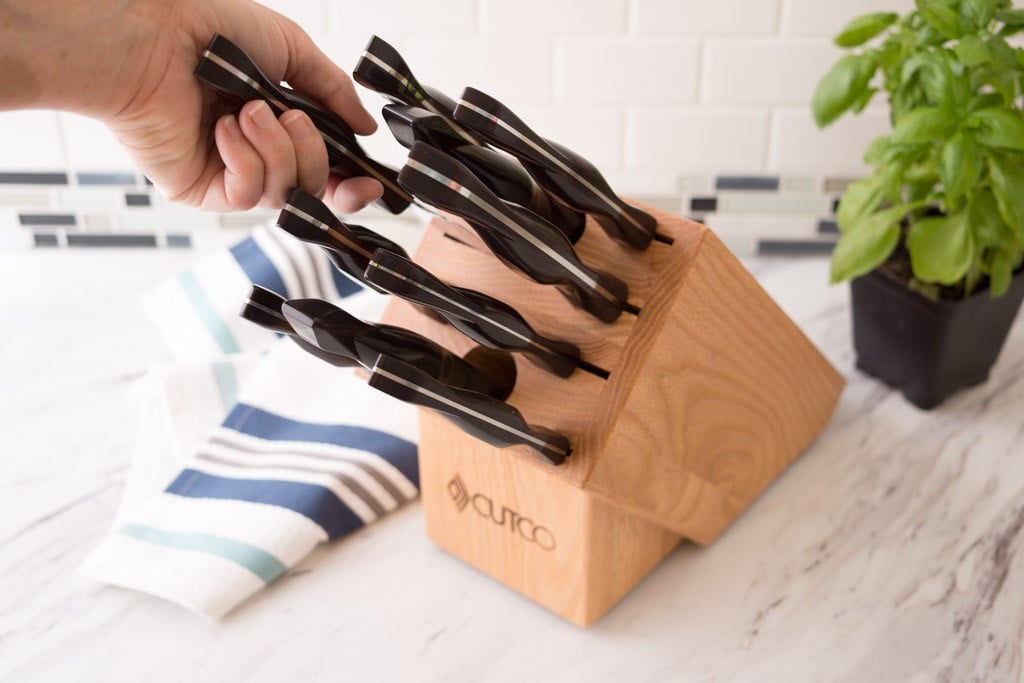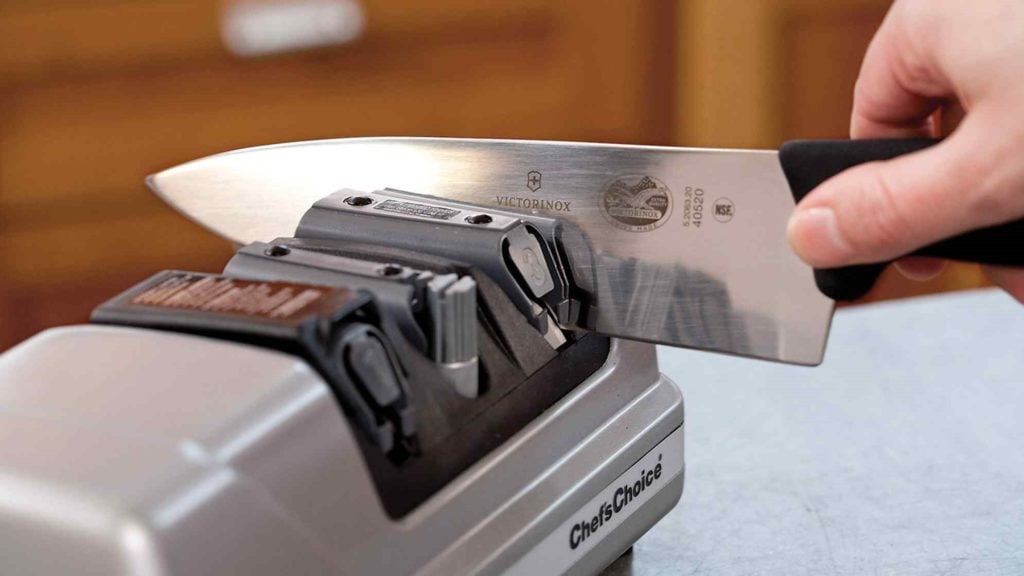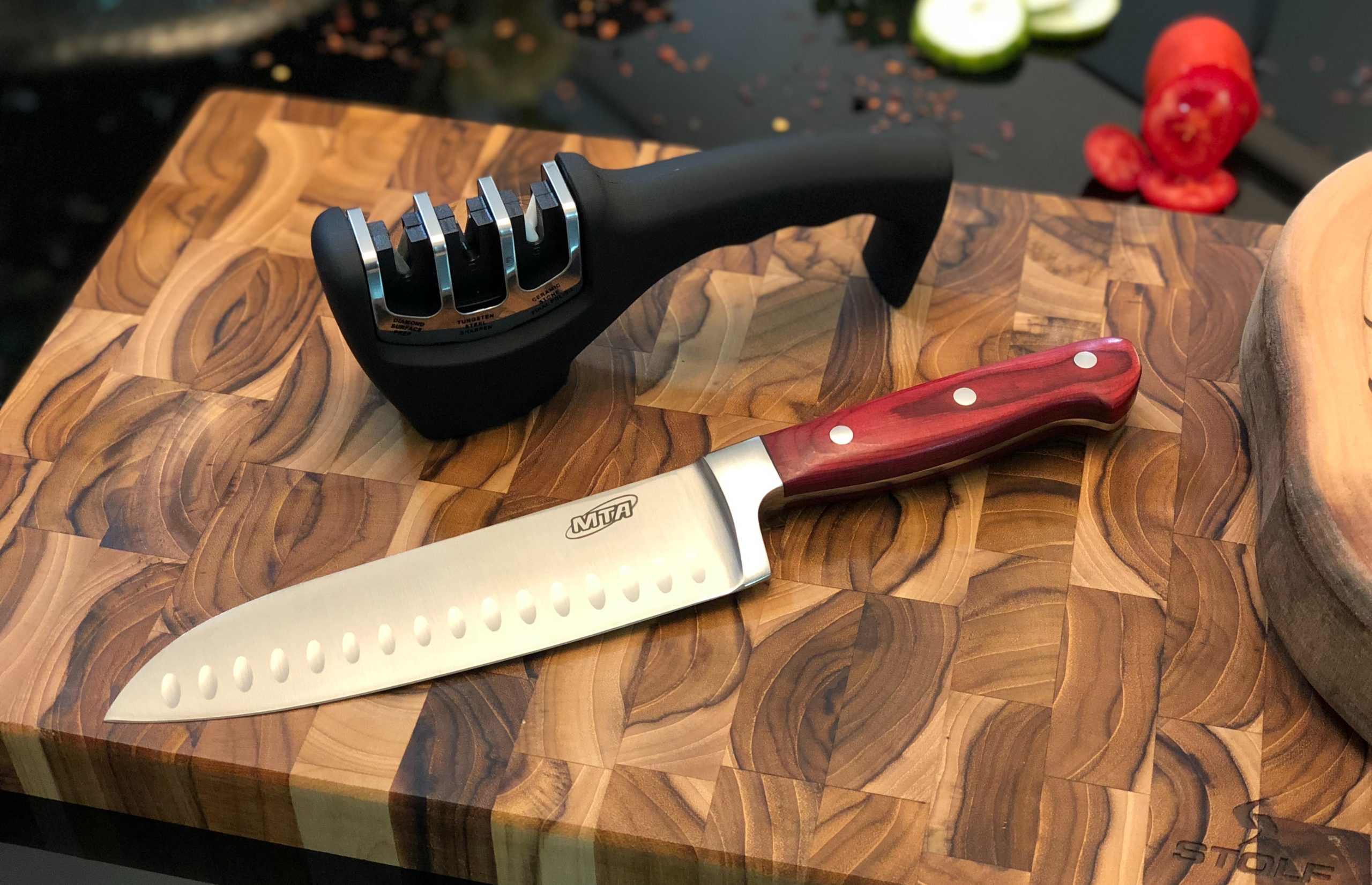We have come up with the importance and benefits of knife sharpening for you. Sit back, drink some beer, and read down below before you cook your meal.
As a kitchen enthusiast, it’s essential to learn how to sharpen your knives. A dull blade can turn meal preparation into a frustrating experience, whereas a sharp knife can make cooking an absolute breeze.
By sharpening your knives, you’ll not only make cutting through ingredients easier, but you’ll also increase your efficiency and safety in the kitchen. If you’re looking to elevate your culinary skills, it’s time to hone your knowledge of knife sharpening.
Why Sharpen Knife?
Sharpening your kitchen knives is an essential skill that can make a world of difference in the kitchen. With a sharp knife, you can effortlessly slice through meats, chop vegetables with ease, and even tackle delicate ingredients like herbs without damaging them. On the other hand, a dull knife can make meal prep a real struggle, requiring excessive force and making it difficult to achieve the precision you need for your dishes. Plus, it can slow you down and make cooking feel like a chore rather than a joy.
The benefits of sharpening your knives go beyond just making meal prep easier. With a sharp blade, you’ll also have better control over your cuts, reducing the risk of slipping and injuring yourself. And when it comes to delicate ingredients like fruits and herbs, a sharp knife will ensure that you’re able to slice through them cleanly, preserving their freshness and texture.
Also Read: 9 Best Healthy Foods for Breast Enhancement
So, whether you’re a seasoned chef or just starting in the kitchen, sharpening your knives is a skill that can take your cooking to the next level. With a little practice and patience, you’ll be able to achieve razor-sharp blades that make meal prep a breeze and cooking a joy!
Advantages and Benefits of Sharpening Knife Yourself
Sharpening your scissors, knives, chisels, axes, and such yourself comes with a couple of benefits.
Benefit 1: Improved Knife Performance
A sharp knife can effortlessly cut through food, which makes meal preparation more efficient and enjoyable. It also reduces the risk of injury since a dull blade requires more force to cut, which increases the chances of slipping and injuring yourself.
Benefit 2: Knife Sharpening Extends Knife Lifespan
Regular sharpening removes nicks and dents from the blade, preventing it from becoming dull and worn out. This prolongs the lifespan of your knife, which means you won’t have to replace it as often.
Benefit 3: Better Taste and Presentation
When you use a sharp knife to cut through food, you can create more precise cuts and slices. This not only enhances the appearance of your food but also improves its taste. A dull blade can crush or tear the food, leading to a less appetizing presentation and a different taste.
Benefit 4: Sharpening Knife is Exciting!
Though it continually comes to the results, sharpening is an enjoyable thing to do. Many people enjoy sharpening their kitchen knives before cooking as it feels fantastic to use a knife you’ve sharpened with a knife sharpener yourself. The feel and look of a sharp knife are exciting, knowing that you can trust it when cutting food or ingredients.
Benefit 5: Discover Nature of Your Knife
Especially pocket since they have a relationship with their knife, knife owners are real fans. But we can imagine that with that mighty, robust felling axe or a gorgeous chef’s knife, it’s possible to experience the identical thing. You have to understand it better by trimming your tool. You discover the specific nature of the knife, how soft or hard the steel is, and get to know the form of the border. You are really going to start to consider it should you sharpen your knife yourself!
Benefit 6: Save Money By Having Sharpening Tools
Obviously: purchasing quality sharpening stuff is a good investment. But what about sending your knives for repairs into a store? That is more expensive. With a complete collection of quality sharpening tools and also stones, you are good to go for decades. Additionally, you may use sharpening tools indefinitely to sharpen knives for free compared to always paying per knife once you ship them to a store for repairs. In the long term, having quality sharpening tools are less costly than when you have them sharpened.
Benefit 7: Safety Using A Sharp Knife
A sharp blade is predictable. If it strikes or is drawn across the surface of the food, it won’t slip. This makes it effortless to control the blade goes through the food, giving you control over your own chopping or slicing. A dull blade will probably slide, which makes control difficult and increases the risk it will slip into your finger. Using a knife, it’s merely a matter of time until you cut on.

Benefit 8: Easy and Quick
It’s neither difficult nor time-consuming to sharpen a knife. Here’s a quick tool of precisely how quick and easy it can be to revive a dull knife that it’s razor-sharp.
The option to sharpening yourself is to use the service of an electrical knife sharpener. It sharpens knives easily and quickly. Read more about the best knife sharpener on besthomethings.com. It is a website that writes about top accessories of the kitchen, and more.

Benefit 9: Sharpen Knives Give Good Returns
A pair of whetstone to get sharpening your knives will cost less, which is excellent. We believe this is a fantastic investment because a collection of knives is futile. A couple rounds at a service will require a set of stones, and the rocks must last you a lifetime.
When someone refers to a whetstone, sharpening stones or bench stone, they are usually referring to a flat block of dense material between 2 and 14 inches long used in the sharpening and shaping of metal tools, such as knives.
Benefit 10: Get Control by Sharpening Knife Yourself
When you sharpen your own knives, you have full control over the angle and bevel of the blade, allowing you to tailor it to your specific needs. For example, you can choose to set a wider angle on the sides of a sturdy chef’s knife, or hone the edge to a shallow angle of 15 degrees on each side for a more delicate blade that slices effortlessly through food.
By taking charge of your own sharpening, you can customize and refine your cutting edge to achieve the desired level of sharpness and micro-serrations for optimal performance on different foods. This gives you the ability to tackle even notoriously tricky foods like ripe tomatoes with ease and precision.
Disadvantages of Outsourced Knife Sharpening
It is, therefore, relatively expensive to get your knives sharpened with a professional. There are a couple of other advantages.
Disadvantage 1: Most Likely, You Will Wait For It To Get Done
Outsourced knife sharpening may seem like a convenient option, but it does have its downsides. For one, it can be quite expensive to have a professional sharpen your knives, which may not be feasible for everyone.
But perhaps the biggest disadvantage is the waiting time. When you send your knives off to be sharpened, you may have to wait several days or even weeks to get them back. This can be impractical if you need your knives for immediate use, such as when preparing a meal.
It can be frustrating to feel like you’re without your trusty kitchen tools, akin to not being able to use your fireplace because your axe is getting sharpened. And for those who are particularly attached to their knives, it can feel like saying goodbye to a dear friend.
Therefore, while outsourced knife sharpening may work for some, it’s important to weigh the costs and inconveniences before deciding if it’s the right choice for you.
How to Use a Knife Sharpening Stone
Dull knives in the kitchen can be a real pain – quite literally! Not only do they make food prep frustrating, but they can also be a safety hazard. That’s why knowing how to sharpen a knife is an essential skill for any cook. And while there are plenty of methods out there, using a sharpening stone is one of the most precise and effective ways to achieve a razor-sharp edge on your blades.
In this section, we’ll take a closer look at how to use a knife sharpening stone and achieve a razor-sharp edge on your blades.
Step 1: Choose the Right Sharpening Stone
There are several types of sharpening stones available on the market, including diamond stones, ceramic stones, water stones, and oil stones. Each type of stone has its pros and cons, so it’s essential to choose the right one for your needs.
If you’re a beginner, a combination water stone with two grits (coarse and fine) is a great place to start. As you get more experienced, you may want to invest in higher-quality stones with finer grits.
Step 2: Set up Your Workspace
Before you begin sharpening your knife, you need to set up your workspace. Place your sharpening stone on a flat and stable surface, like a countertop or table. You may also want to place a towel or non-slip mat underneath the stone to prevent it from moving around.
Step 3: Lubricate the Sharpening Stone
Most sharpening stones require lubrication to prevent the blade from getting damaged and to ensure a smooth sharpening process. Water stones require water, while oil stones need oil. Follow the manufacturer’s instructions to know the appropriate lubrication for your specific sharpening stone.
Step 4: Position the Knife
Hold the knife’s handle with one hand and place the blade’s edge against the sharpening stone at a 20-degree angle. You can use a sharpening guide to help you maintain the correct angle.
Step 5: Sharpen the Knife
Using moderate pressure, slide the blade across the stone, moving from the base to the tip in a sweeping motion. Make sure to maintain the correct angle throughout the sharpening process. Repeat this process on both sides of the blade until you achieve the desired sharpness.
Step 6: Test the Sharpness
To test the knife’s sharpness, gently drag the blade across a piece of paper. If the knife cuts the paper cleanly and easily, then it’s sharp enough for most kitchen tasks.
Step 7: Clean and Store Your Sharpening Stone and Knife
After you’ve finished sharpening your knife, clean the sharpening stone with water and a non-abrasive brush. Dry the stone thoroughly and store it in a cool, dry place. Wipe the knife clean with a damp cloth and store it in a safe place.
Mastering the use of a knife sharpening stone can help keep your kitchen knives in top shape and ensure safe food preparation. With practice and patience, you can learn how to use this method to achieve a razor-sharp edge on your blades. Remember to choose the right stone, set up your workspace properly, and follow the correct sharpening technique. Now that you have the knowledge, get ready to impress your friends and family with your newfound sharpening skills!
Knife Sharpening: Common Questions Answered
How do I know if my knife needs sharpening?
You can tell if your knife needs sharpening if it is dull and not cutting as easily or effectively as it used to. You may also notice that it takes more force to cut through food, or that the blade has visible nicks or chips.
What’s the difference between honing and sharpening?
Honing is the process of straightening the blade of your knife, while sharpening is the process of removing material to create a new, sharper edge. Honing is often done with a honing rod, while sharpening is done with a sharpening stone or other sharpening tool.
What type of sharpening method is best for my knives?
The best sharpening method for your knives will depend on the type of knives you have, their condition, and your personal preference. Some common sharpening methods include using a sharpening stone, a honing rod, or an electric knife sharpener.
Can I sharpen my knives at home, or do I need to take them to a professional?
You can sharpen your knives at home with the right tools and technique. However, if you’re not comfortable doing it yourself or your knives require professional attention due to significant damage or wear, it’s best to take them to a professional.
How often should I sharpen my knives?
The frequency with which you should sharpen your knives depends on how often you use them and what you use them for. In general, it’s a good idea to sharpen your knives every few months to maintain their sharpness.
What are some common mistakes to avoid when sharpening knives?
Common mistakes when sharpening knives include using the wrong angle, not applying enough pressure, and not properly cleaning or maintaining your sharpening tools.
How can I tell if I’m using the correct angle when sharpening my knives?
The correct angle to sharpen your knives will vary depending on the type of knife and its intended use. A good rule of thumb is to use a 20-degree angle for most kitchen knives.
What types of knives require a special sharpening technique?
Certain knives, such as serrated knives or Japanese-style knives, may require a special sharpening technique. It’s important to research the proper sharpening technique for your specific type of knife.
How can I care for my knives to prolong their sharpness?
To prolong the sharpness of your knives, it’s important to store them properly (such as in a knife block or on a magnetic strip), clean them after each use, and avoid using them on hard surfaces like glass or stone.
What are some signs that my knives need to be replaced rather than sharpened?
If your knife has significant damage such as a broken tip or handle, or if it has been sharpened many times and the blade is significantly shorter than when you first purchased it, it may be time to replace the knife rather than trying to sharpen it further.
Do you push or pull when sharpening a knife?
Both pushing and pulling can be used when sharpening a knife, depending on the type of sharpening method being used. For example, with a sharpening stone, you typically move the knife blade in a back-and-forth motion, alternating between pushing and pulling the blade across the stone.
On the other hand, with a honing rod, you typically only use a pulling motion, as you run the blade along the length of the rod at a consistent angle. It’s important to follow the instructions for the specific sharpening method you are using to ensure you are using the correct technique.
How much does knife sharpening cost?
The cost of knife sharpening can vary depending on a few factors such as the type of knife, the condition of the blade, and where you live. On average, a professional knife sharpening service can cost anywhere from $5 to $15 per knife, with some services offering bulk discounts.
However, prices can range higher for more specialized knives or for rush services. It’s also worth noting that some people choose to invest in their own knife sharpening tools, which can range in price from a few dollars for a basic sharpening stone to hundreds of dollars for an advanced sharpening system.
How to start a knife sharpening business?
Starting a knife sharpening business requires careful planning and preparation. Here are some steps you can take:
Research the market: Do some research on the local market to determine if there is a demand for knife sharpening services. Identify potential competitors and their pricing and services offered.
Develop a business plan: Create a business plan that outlines your services, target market, pricing, and marketing strategies. Determine your startup costs and projected revenue.
Obtain necessary equipment: Purchase the necessary equipment for knife sharpening, such as a sharpening stone, grinder, and honing steel.
Register your business: Register your business with the appropriate government agencies and obtain any necessary licenses or permits.
Set up your workspace: Set up a workspace for your business, including a table or workbench for sharpening knives, storage for equipment and supplies, and a system for tracking orders.
Develop a pricing strategy: Determine how much you will charge for your services. Consider offering discounts for larger orders or repeat customers.
Market your business: Develop a marketing plan to reach potential customers. Consider advertising in local newspapers, setting up a website or social media presence, and distributing flyers or business cards.
Starting a knife sharpening business can be a rewarding and profitable venture for those who are passionate about knives and have a desire to provide quality service to their customers.
How much pressure when sharpening a knife?
The amount of pressure to use when sharpening a knife depends on the type of sharpening method you are using and the condition of the blade.
As a general rule, you should use a light to moderate pressure when sharpening a knife. Too much pressure can damage the blade or remove too much material, while too little pressure may not achieve the desired level of sharpness.
It’s important to follow the instructions for the specific sharpening method you are using and to use consistent pressure throughout the process. With practice, you’ll develop a feel for the right amount of pressure to use.
How to clean a knife sharpening stone?
Cleaning a knife sharpening stone is essential to keep it in good condition and ensure that it performs optimally. Here’s how you can clean your knife sharpening stone:
1. First, remove any visible debris from the surface of the stone using a soft-bristled brush or a cloth. You can also use a knife to scrape off any caked-on particles.
2. Next, wet the stone with water or honing oil to prepare it for cleaning.
3. Apply a few drops of a cleaning solution or mild detergent to the surface of the stone. You can use a commercial sharpening stone cleaner or a mixture of warm water and dish soap.
4. Using a soft-bristled brush, gently scrub the surface of the stone in circular motions. Pay special attention to any areas with stubborn stains or discoloration.
5. Rinse the stone thoroughly with clean water to remove any residue from the cleaning solution.
6. Let the stone air dry completely before storing it.
It’s important to note that some sharpening stones may require specific cleaning instructions depending on the type of material they are made from. Always refer to the manufacturer’s recommendations before cleaning your sharpening stone.
How to extend knife’s life?
To extend the life of your knife, here are some tips:
Store your knives properly: Don’t just throw your knives in a drawer or leave them lying around. Use a knife block, magnetic strip, or blade guard to protect the blades and prevent them from getting damaged.
Use a cutting board: Always use a cutting board when chopping or slicing with your knife. Cutting on hard surfaces like metal or ceramic can damage the blade.
Hand wash your knives: Avoid putting your knives in the dishwasher, as the harsh detergents and high heat can damage the blades. Instead, hand wash them with warm water and mild soap, then dry them thoroughly.
Hone your knife regularly: Use a honing rod to keep your knife’s edge straight and aligned. This will help maintain its sharpness and prevent it from becoming dull.
Sharpen your knife when needed: When your knife starts to feel dull, it’s time to sharpen it. You can use a sharpening stone or take it to a professional sharpener.
Don’t use your knife as a tool: Avoid using your knife to pry open cans or jars, or to cut through hard materials like bones or frozen food. This can damage the blade and shorten its lifespan.
By following these tips, you can help extend the life of your knife and keep it in top condition for years to come.
At what angle should you sharpen a Japanese knife?
The sharpening angle for Japanese knives can vary depending on the specific type of knife and its intended use.
However, in general, most Japanese knives are sharpened at an angle between 15 and 20 degrees. Some Japanese knives, such as Yanagiba and Deba knives, may be sharpened at an even steeper angle for more precise cuts.
It’s important to note that the optimal sharpening angle can also vary based on the hardness of the steel used in the knife’s construction.
How to sharpen a knife with a sharpening stick?
Sharpening a knife with a sharpening stick can be a quick and easy way to maintain a sharp edge on your blade. Here are the steps to follow:
1. Hold the sharpening stick firmly with your non-dominant hand.
2. Place the blade of the knife against the sharpening stick at the desired angle (usually around 20 degrees).
3. Keeping the angle consistent, draw the blade down the sharpening stick from the base of the blade to the tip.
4. Repeat this process on the other side of the blade, making sure to maintain the same angle.
5. Continue alternating sides, making several passes on each side until the blade is sharp.
Remember to use a light touch and let the sharpening stick do the work. With a little practice, you’ll be able to keep your knives sharp and ready for all your culinary adventures!
Regular Knife Sharpening for Your Kitchen and Cooking Experience
To sum up, sharpening your kitchen knives is a crucial practice that can make a significant difference in your cooking experience. Not only does it make meal preparation easier and more efficient, but it also promotes safety and helps you achieve better results in your dishes.
By investing in the right sharpening tools and mastering the techniques, you can extend the lifespan of your knives and elevate your culinary skills to a whole new level. So, don’t underestimate the importance of knife sharpening and make it a part of your routine to enjoy the many benefits it brings to your kitchen.
Also Read: The Best Heat Protection Spray For Fine Hair
Well, what do you think about the article?
Do you like reading the “Importance And Benefits Of Knife Sharpening“? If so, please comment down below. We would love to hear your thoughts about this.
To see more content like this check the guides section of Money For My Beer.

Muhammad Irshad is enthusiastic about the conclusion that inspires within each of us and shaping it into a model. His work/life improvement procedures have facilitated uncountable men, women to lead more vibrant lives while reducing the responsibility and the mission for excellence.
Author: Best Home Things | Sow Your Money


You made a good point when you said that a sharpened knife is safer since it’s predictable and easier to control than a dull knife that may slide and cut you. The knives in my mom’s kitchen have become dull since it has never been sharpened since she bought it. I’ll share what you said with her, so she’ll have the blades sharpened soon. Thanks.
Great blog and excellent instructions. I have sharpened my knives western style alternating the direction and side of knife on each stroke. This is very hard to maintain the same level. Your method is much easier to control. My stones were in terrible shape. They are now flat and all my knives are very happy. Thanks for sharing your technique.
I’m glad that you like what we have written. Thanks.